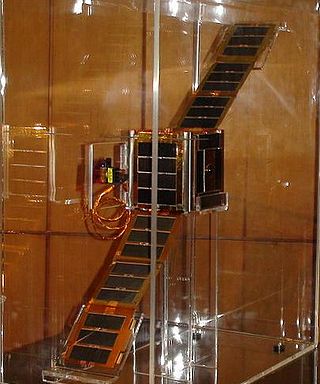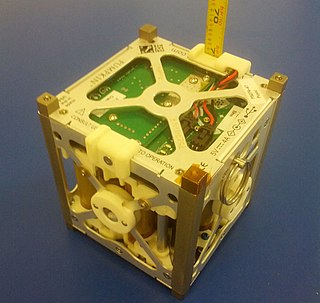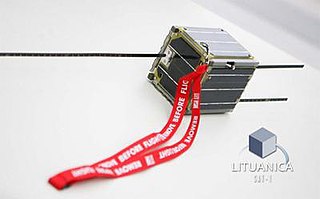
A CubeSat is a class of miniaturized satellite based around a form factor consisting of 10 cm (3.9 in) cubes. CubeSats have a mass of no more than 2 kg (4.4 lb) per unit, and often use commercial off-the-shelf (COTS) components for their electronics and structure. CubeSats are put into orbit by deployers on the International Space Station, or launched as secondary payloads on a launch vehicle. As of August 2021, more than 1,600 CubeSats have been launched.
RAIKO is a Japanese satellite which was built and operated by Tohoku and Wakayama Universities. A two-unit CubeSat, RAIKO was deployed from the International Space Station (ISS) on 4 October 2012, having been launched on 21 July 2012.

A small satellite, miniaturized satellite, or smallsat is a satellite of low mass and size, usually under 1,200 kg (2,600 lb). While all such satellites can be referred to as "small", different classifications are used to categorize them based on mass. Satellites can be built small to reduce the large economic cost of launch vehicles and the costs associated with construction. Miniature satellites, especially in large numbers, may be more useful than fewer, larger ones for some purposes – for example, gathering of scientific data and radio relay. Technical challenges in the construction of small satellites may include the lack of sufficient power storage or of room for a propulsion system.

SES S.A. is a Luxembourgish satellite telecommunications network provider supplying video and data connectivity worldwide to broadcasters, content and internet service providers, mobile and fixed network operators, governments and institutions.

ELA-3, is a launch pad and associated facilities at the Centre Spatial Guyanais in French Guiana. ELA-3 is operated by Arianespace as part of the expendable launch system for Ariane 5 launch vehicles. As of September 2022, 114 launches have been carried out from it, the first of which occurred on 4 June 1996.

NEE-01 Pegaso is an Ecuadorian technology demonstration satellite, and Ecuador's first satellite launched to space. Built by the Ecuadorian Civilian Space Agency (EXA), it is a nanosatellite of the single-unit CubeSat class. The spacecraft's instruments include a dual visible and infrared camera which allows the spacecraft to take pictures and transmit live video from space.

KickSat was a satellite dispenser for small-satellite (femtosatellite) project inaugurated in early October 2011, to launch many very small satellites from a 3U CubeSat. The satellites have been characterized as being the size of a large postage stamp. and also as "cracker size". The mission launch was originally scheduled for late 2013 and was launched April 18, 2014.
Technology Education Satellite (TechEdSat) is a successful nano-sat flight series conducted from the NASA Ames Research Center in collaboration with numerous universities. While one of the principal aims has been to introduce young professionals and university students to the practical realm of developing space flight hardware, considerable innovations have been introduced. In addition, this evolving flight platform has tested concepts for Low Earth Orbit (LEO) sample return, as well as planetary nano-sat class mission concepts.

SpaceX CRS-3, also known as SpX-3, was a Commercial Resupply Service mission to the International Space Station (ISS), contracted to NASA, which was launched on 18 April 2014. It was the fifth flight for SpaceX's uncrewed Dragon cargo spacecraft and the third SpaceX operational mission contracted to NASA under a Commercial Resupply Services (CRS-1) contract.

Alexander, also known as PhoneSat 2.0 Beta or PhoneSat v2a is a technology demonstration satellite operated by NASA's Ames Research Center, which was launched in April 2013. Part of the PhoneSat programme, it was one of the first three PhoneSat spacecraft, and the first Phonesat-2.0 satellite, to be launched.

Graham, also known as PhoneSat 1.0a or PhoneSat v1a was a technology demonstration satellite operated by NASA's Ames Research Center, which was launched in April 2013. Part of the PhoneSat programme, it was one of the first three PhoneSat spacecraft to be launched.

LituanicaSAT-1 was one of the first two Lithuanian satellites. It was launched along with the second Cygnus spacecraft and 28 Flock-1 CubeSats aboard an Antares 120 carrier rocket flying from Pad 0B at the Mid-Atlantic Regional Spaceport on Wallops Island to the International Space Station. The launch was scheduled to occur in December 2013, but later was rescheduled to 9 January 2014 and occurred then. The satellite was broadcasting greetings of Lithuanian president, Mrs. Dalia Grybauskaitė. The satellite was deployed from the International Space Station via the NanoRacks CubeSat Deployer on February 28, 2014. All LituanicaSAT-1 subsystems have been turned on, tested and proved to be working properly. The mission is considered a complete success by its team of engineers. The mission ended upon the reentry and disintegration of the satellite on July 28, 2014.

Planet Labs PBC is an American public Earth imaging company based in San Francisco, California. Their goal is to image the entirety of the Earth daily to monitor changes and pinpoint trends.

The Lithuanian Space Association is a space organisation based in Vilnius, Lithuania. It is one of the partners that created the first two Lithuanian satellites.

SkyCube was an American crowdsourced CubeSat. It was first announced on Kickstarter on 14 July 2012 and successfully funded on 12 September 2012, meeting its US$82,500 goal with a total of US$116,890. It was developed and built in 2012–2013, completed flight integration at Nanoracks in late 2013, and launched aboard the Cygnus CRS Orb-1 flight at the Mid-Atlantic Regional Spaceport on Wallops Island, Virginia on 9 January 2014. SkyCube was deployed from the International Space Station on 28 February 2014. Contact with the satellite was last made on 27 March 2014. SkyCube re-entered the Earth's atmosphere on 9 November 2014. It is one of several crowdfunded satellites launched during the 2010s.

The Nanoracks CubeSat Deployer (NRCSD) is a device to deploy CubeSats into orbit from the International Space Station (ISS).
LituanicaSAT-2 is a 3U Lithuanian CubeSat satellite launched on a polar satellite launch vehicle. This mission is led by Vilnius University in cooperation with NanoAvionics and is a part of the international "QB50" mission. LituanicaSAT-2 is an in-orbit technology demonstration mission during which the propulsion system prototype for small satellites will be tested. The satellite was deployed in sun- synchronous orbit at an altitude of 475 km.
NanoAvionics Corp is an advanced small satellite bus manufacturer and mission integrator founded as a spin-off from Vilnius University, Lithuania in 2014.














